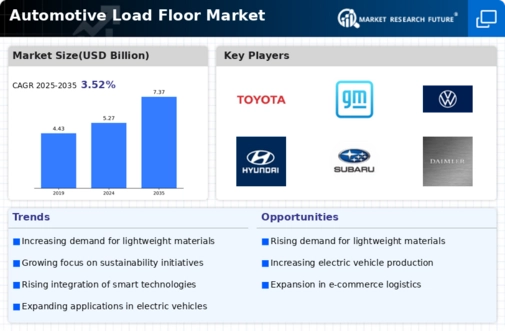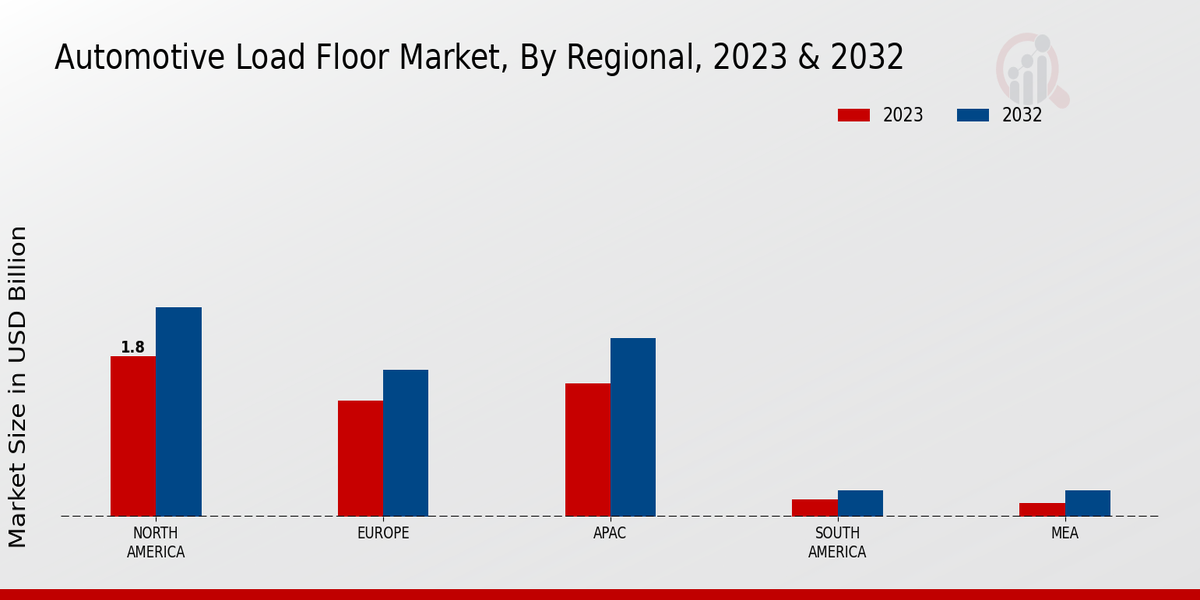Market Growth Projections
The Global Automotive Load Floor Market Industry is poised for substantial growth, with projections indicating a market value of 5.27 USD Billion in 2024 and an anticipated increase to 7.37 USD Billion by 2035. This growth trajectory suggests a compound annual growth rate (CAGR) of 3.1% from 2025 to 2035. The factors contributing to this growth include rising vehicle production, technological advancements, and increasing consumer demand for innovative load floor solutions. As the automotive industry continues to evolve, the load floor market is likely to adapt, presenting opportunities for manufacturers to enhance product offerings and meet changing consumer preferences.
Shift Towards Electric Vehicles
The transition towards electric vehicles (EVs) is reshaping the Global Automotive Load Floor Market Industry. As automakers increasingly invest in EV technology, the design and materials used in load floors are adapting to accommodate battery integration and weight distribution. This shift not only enhances vehicle performance but also aligns with global sustainability goals. The growing consumer preference for environmentally friendly vehicles further propels this trend. As the market evolves, manufacturers are likely to innovate load floor designs that optimize space and functionality, thereby enhancing the overall driving experience for EV users.
Increasing Vehicle Production and Sales
The Global Automotive Load Floor Market Industry is significantly influenced by the rising production and sales of vehicles worldwide. As emerging economies continue to develop, the demand for personal and commercial vehicles is on the rise. This trend is particularly evident in regions such as Asia-Pacific, where urbanization and economic growth drive automotive sales. The anticipated growth in vehicle production is expected to propel the load floor market, with projections indicating a market value of 7.37 USD Billion by 2035. Consequently, manufacturers are focusing on optimizing load floor designs to meet the evolving needs of consumers and regulatory standards.
Growing Demand for Lightweight Materials
The Global Automotive Load Floor Market Industry experiences a notable shift towards lightweight materials, driven by the automotive sector's increasing focus on fuel efficiency and emissions reduction. Manufacturers are increasingly adopting materials such as composites and advanced plastics to reduce vehicle weight. This trend aligns with global regulatory frameworks aimed at lowering carbon footprints. As a result, the market is projected to reach 5.27 USD Billion in 2024, reflecting the industry's commitment to sustainable practices. The integration of lightweight load floors not only enhances vehicle performance but also contributes to overall safety, thereby appealing to both manufacturers and consumers.
Regulatory Compliance and Safety Standards
Regulatory compliance and safety standards are critical drivers of the Global Automotive Load Floor Market Industry. Governments worldwide are implementing stringent regulations to ensure vehicle safety and environmental sustainability. These regulations often necessitate the use of advanced materials and designs in load floors to enhance structural integrity and passenger safety. Manufacturers are compelled to innovate and adapt their load floor designs to meet these evolving standards. As a result, the market is expected to witness sustained growth, with an increasing emphasis on compliance driving innovation and investment in safer, more efficient load floor solutions.
Technological Advancements in Manufacturing Processes
Technological innovations play a pivotal role in shaping the Global Automotive Load Floor Market Industry. Advanced manufacturing techniques, such as 3D printing and automated assembly, are enhancing production efficiency and precision. These advancements allow for the creation of complex load floor designs that cater to diverse vehicle models. As manufacturers adopt these technologies, they can reduce production costs and lead times, ultimately benefiting consumers. The market is expected to grow at a CAGR of 3.1% from 2025 to 2035, indicating a sustained interest in innovative manufacturing solutions that enhance product quality and performance.

























